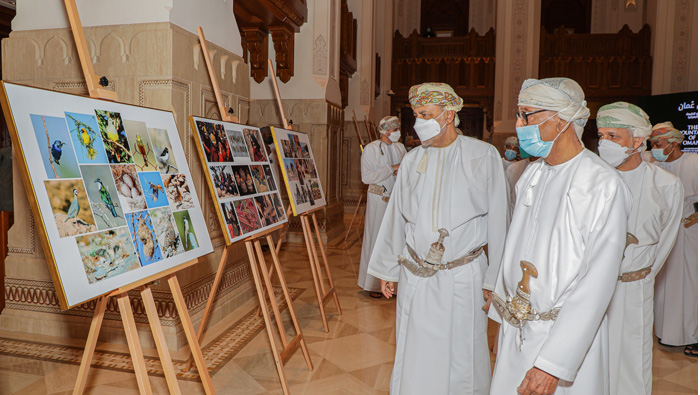
MUSCAT: Under the auspices of His Highness Sayyid Shihab bin Tarik Al Said, Deputy Prime Minister for Defence, The Mountains of Oman Encyclopaedia was launched at the Royal Opera House Muscat.
Also, present was Mohammad Al Zubair, who supervised this valuable project as per the directives of the late Sultan Qaboos bin Said bin Taimur – may the Almighty rest his soul in peace.
The 1,700 pages of the new encyclopaedia, spread over three large volumes, contain detailed information about the mountain ranges of the Sultanate, highlighting their geographical and geological importance, their role in the development of the nation as well as the settlements and unique agricultural and biological diversity.
The encyclopaedia covers 409 mountains in the Sultanate, with heights ranging from 30 metres (Jebel Musanjab, Wilayat of Masirah, South Al Sharqiyah Governorate) to 3,009 metres. Jebel Shams (Wilayat of Al Hamra, Al Dakhiliyah Governorate) is considered one of the highest mountains on the Arabian Peninsula.
Commenting on the launch of the encyclopaedia, Mohammad Al Zubair said, “I have a firm belief –and I think many share the same- that the mountains of Oman are the most significant undiscovered treasures in the Sultanate. Not only for the wealth they hold underground, but also because of their natural beauty, which lends itself to tourism promotion. Many countries rely on their topography to develop unique tourism products that attract certain categories of tourists from all over the world.
“In Oman, we are blessed with a unique natural terrains, including our mountain chains with their special formations and rare biodiversity. The Mountains of Oman will shed light on these mountains and empower entities such as the Ministry of Heritage and Tourism, Ministry of Energy and Minerals, Ministry of Agriculture, Fisheries and Water Resources, and others to properly make use of this unique natural resource.
“This journey began under the guidance of the late Sultan Qaboos bin Said bin Taimur – may the Almighty rest his soul in peace –, who foresaw the need for an accurate scientific reference on the mountains of Oman and its various formations, to act as a source of information for researchers, students as well as entities involved in the country’s social and economic development.
“After I was commissioned by the late His Majesty to supervise the project, we gathered a group of more than 100 experts in the fields of geography, geology, agriculture, livestock and water resources, as well as history and other areas, to develop the content for this huge encyclopaedia, a project that took years. Today, we are honoured to gift it to the nation and the memory of our late leader, who initiated the project before he passed, but continues to live on in our hearts and memory,” he added.
The scientific committee supervising the encyclopaedia included scientific experts across various fields, working together underthe helm of Project Director and Co-Chief Editor Dr. Said Mohammed Al Saqri, Minister of Economy, and Co-Chief Editor Dr. Birgit Mershen, Fellow Researcher in Oriental and Islamic Studies- Ruhr University Bochum in Germany.
The committee also included Dr. Abdullah Al Ghafri (Head Falaj Research Unit- Nizwa University), Lieutenant Colonel Yousuf Al Nabhani (Acting Director of Geographic Information Services -National Survey Authority/Ministry of Defence), Dr. Annette Patzelt (Director of Science- Oman Botanic Garden), Dr. Andrew Spalton (Adviser for Environmental Affairs - Office of the Minister/Diwan of Royal Court), Dr. Talal Al Hosni (Head of Earth Sciences Department- Sultan Qaboos University), Prof. Dr.Sobhi Nasir(UNESCO Chair for Ophiolite Studies, Director Earth Sciences Research Centre- Sultan Qaboos University), and Dr. Ali Al Rajhi) Director General of Geological Surveys and Research –(former) Public Authority for Mining.
Commenting on the efforts made to produce the encyclopaedia’s content, Dr. Said Al Saqri said, “We thought in the beginning that this project would not take more than one or two years to complete. However, when we began to map out the outline for the book- which later became an encyclopaedia- we discovered that the role of mountain ranges in the Sultanate extend beyond their geographical and geological features, in fact they have influenced the social and demographic development of Oman and its civilization for thousands of years. This has made it vital, when developing the encyclopaedia, to conduct scientific research in great detail, creating and approving accurate maps and charts that researchers and planners can refer to as a helpful source of information. We are proud of the end product, Encyclopaedia of the Mountains of Oman, that is an invaluable addition to the studies on the Sultanate.”
The flora and vegetation of the mountains in Oman are unique on a global scale, with many plants just found here and nowhere else on the planet. Rich in natural and cultural heritage, the mountains of Oman are repositories of biodiversity and home to agricultural villages that are thousands of years old. The ‘Mountains of Oman’ project is a major step towards sustainable mountain development and to help protect the rich biodiversity found here.
The project is designed as an invaluable reference to inform and guide planning and development policy and decision making across the country. As well as its role in raising the spirit of curiosity among readers and encouraging them to adventure and explore mountainous areas with a unique environment. The encyclopaedia will be available for purchase for March 2021.